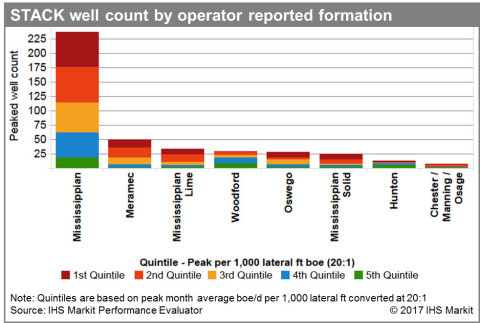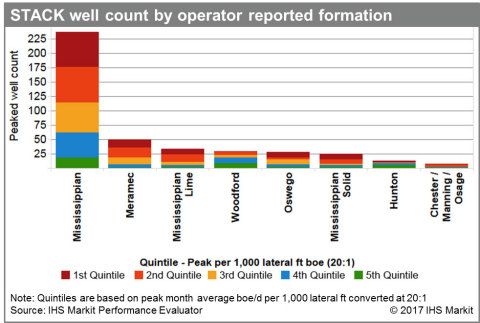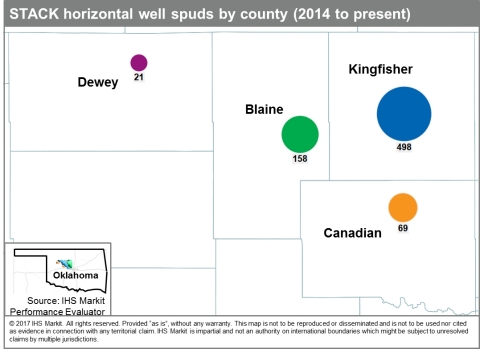HOUSTON--(BUSINESS WIRE)--Despite the fact that the Oklahoma STACK oil and gas play is still evolving and its total potential is undetermined, evidence thus far indicates the play is delivering impressive results, leading operators to commit significant 2017 CAPEX to its development, according to new analysis from IHS Markit (Nasdaq: INFO), a world leader in critical information, analytics and solutions.
“The Oklahoma STACK (Sooner Trend Anadarko Basin Canadian and Kingfisher County) play is early in its development but wells have shown great productivity,” said Imre Kugler, associate director, energy research at IHS Markit and author of the IHS Markit Plays and Basins: Oklahoma STACK analysis. “Questions still remain regarding potential across various horizons; however, for operators with acreage and capital to test the play, economic upside exists so the biggest six operators in the play are on track to invest more than $2.5 billion during 2017.”
Whether the play will be a major contributor to domestic supply is still undetermined, Kugler said. “To date, fewer than 1,000 wells have been brought online in the liquids-rich STACK play, but estimated break-evens for first quintile wells in the play are quite low and competitive with top Permian plays. First quintile wells in the STACK for both short- and long-laterals are estimated to break even under $30 per barrel.”
The early stage of the STACK play equates to some variance in well performance as operators seek to optimize development. The spread between first and second quintile wells is wider when compared with the relatively more well-known Permian plays, with second quintile STACK wells estimated to break even near $41 per barrel for longer laterals, and $55 per barrel for shorter laterals, IHS Markit said.
“The Oklahoma STACK play is economic for many operators at current prices and it offers multiple drilling targets due to its complex geology, which is attractive for drillers seeking to leverage pads to expand resources,” Kugler said. “While the play covers about one-fifth the aerial extent of the Permian Basin, it is attractive to many operators who find the Permian over-heated in terms of acreage availability and cost of entry. The STACK and the Anadarko Basin offer attractive investments, lower entry costs, and the potential for economic returns, and the play is becoming a core focus for several companies.”
The STACK play is located in the northern Anadarko Basin, the deepest Phanerozoic basin on the North American craton. It contains more than 40,000 vertical feet of sediments that were deposited in a relatively shallow-water, platform environment. Operators have identified as many as 10 horizontal targets in the play, including the various Mississippian formations, as well as Woodford, Hunton, and Oswego reported formations. These formations have been most productive in Oklahoma’s Kingfisher, Canadian, Dewey and Blaine Counties.
While a clear sweet spot has not been established, the most promising region is the over-pressured Meramec area in southeastern Kingfisher and adjacent areas of Blaine and Canadian counties, the IHS Markit report noted. This area has higher average productivity and lacks lower quintile wells.
Wells in northeast Kingfisher County are generally 7,000 feet deep or less, where operators are targeting the shallower Oswego Formation. Wells in the Kingfisher fairway in the southwest portion of the county range from 7,000 feet to 8,500 feet, where the primary target is the Meramec Formation. There is a steep subsurface drop-off into Blaine County, noted the IHS Markit report, where operators target the Woodford Formation, with depths quickly exceeding 10,000 feet. To the west of Kingfisher County, the play deepens below 10,000 feet and liquids content falls significantly—the western area wells produce dry gas or wet gas, with very few oil-prone wells.
Main operators in the play include Devon Energy, Newfield Energy, Marathon Oil, Chesapeake Energy, Continental Resources, Cimarex Energy, Payrock Energy and Oklahoma Energy. Newfield is a play pioneer credited with naming the play, and the company considers the STACK a core part of its portfolio, as does Devon Energy.
In July 2017, Devon Energy Corp. announced it brought online a “record-setting” Privott 17-H Meramec well in Kingfisher County that achieved a “‘facility-constrained’ peak 24-hour rate of 6,000 barrels of oil-equivalent (BOE) per day (50 percent oil).” Devon’s announcement went on to say that, ”when compared against publicly available data in the STACK, the 10,000 foot lateral Privott well achieved the highest initial production rate of any well by a wide margin and is expected to recover in excess of 2 million BOE over the life of the well.”
Devon also brought online four additional high-rate Meramec wells in the core of the over-pressured oil window during the second quarter of 2017. In aggregate, these four wells attained an average 30-day initial production rate of 2,000 BOE per day. These well results were even more impressive on a per-lateral-foot basis with average well productivity of greater than 300 BOE per day per 1,000 feet of gross perforated interval.
According to the IHS Markit report, peak per-lateral foot productivity in the STACK has made substantial improvements and is comparable to the Eagle Ford shale play, both of which are closing in on Permian results. The STACK peak-month productivity averaged above 110 BOE per day (20:1) per 1,000 lateral feet in 2016.
“Drilling and completion trends in the STACK are leaning toward longer laterals (10,000 feet) that now account for about 40 percent of new wells and increased proppant (upward of 2,500 pounds per foot),” Kugler said. “However, although some operators are still developing wells with shorter laterals (4,500 foot) and less proppant, the estimated economics appear to favor the longer laterals. The STACK story continues to feature geographic and vertical expansion as Tapstone and others achieve solid results westward, and operators are mentioning Oswego, Osage, Hunton and other formations, compared with mostly Meramec mentions during 2016.”
To speak with Imre Kugler, please contact Melissa Manning at melissa.manning@ihsmarkit.com. For more information on the IHS Markit Plays and Basins: Oklahoma STACK analysis, please contact sheana.hamill@ihsmarkit.com.
About IHS Markit (www.ihsmarkit.com)
IHS Markit (Nasdaq: INFO) is a world leader in critical information, analytics and solutions for the major industries and markets that drive economies worldwide. The company delivers next-generation information, analytics and solutions to customers in business, finance and government, improving their operational efficiency and providing deep insights that lead to well-informed, confident decisions. IHS Markit has more than 50,000 key business and government customers, including 85 percent of the Fortune Global 500 and the world’s leading financial institutions. Headquartered in London, IHS Markit is committed to sustainable, profitable growth.
IHS Markit is a registered trademark of IHS Markit Ltd and/or its affiliates. All other company and product names may be trademarks of their respective owners © 2017 IHS Markit Ltd. All rights reserved.



